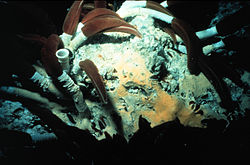Siboglinidae: Difference between revisions
Undid revision 348061380 by Gimme danger (talk) oops |
|||
| Line 48: | Line 48: | ||
{{Commons|Category:Pogonophora|Pogonophora}} |
{{Commons|Category:Pogonophora|Pogonophora}} |
||
[[Category:Sabellida]] |
|||
Revision as of 07:30, 6 March 2010
| Siboglinidae | |
|---|---|

| |
| Riftia pachyptila | |
| Scientific classification | |
| Kingdom: | |
| Subkingdom: | |
| Phylum: | |
| Class: | |
| Subclass: | |
| Order: | |
| Family: | Siboglinidae Caullery, 1914
|
| Genera | |
|
See text. | |
Siboglinidae, also known as the beard worms, is a family of polychaete annelid worms whose members made up the former phyla Pogonophora (the giant tube worms) and Vestimentifera.[1][2] They are composed of about 100 species of vermiform creatures and live in thin tubes buried in sediments at ocean depths from 100 to 10,000 m. They can also be found in association with hydrothermal vents, methane seeps, with sunken plant material or whale carcasses.
Anatomy
Most are less than 1 mm in diameter but 10 to 75 cm in length. They have a complex closed circulatory system and a well developed nervous system. They are the only known animals that, as adults, completely lack a mouth, gut and anus.[3] Their body is divided into four regions; the cephalic lobe, forepart, trunk, and opisthosoma. The anterior is called the cephalic lobe, which bears from 1 to over 200 thin branchial tentacles, which bears tiny side branches known as pinnules. Posterior to the cephalic lobe is the short forepart, and then the elongate trunk, which bears various annuli, papillae, and ciliary tracts. Posterior to the trunk is the short metamerically segmented opisthosoma, that contains serially arranged coelomic spaces separated by septa and bears external paired chaetae.
Vestimentiferans
Like other tube worms, vestimentiferans are marine and benthic. Riftia pachyptila, a vestimentiferan, is known only from the hydrothermal vent systems. The vestimentiferans possess an anterior first body part called the obturaculum. Their main trunk of the body bears winglike extensions, the vestimentum, from which their name is derived. Also, unlike other siboglinids that never have a digestive tract, they have one that they completely lose during metamorphosis. They feed primarily on symbiotic hydrogen sulfide- or methane-oxidizing bacteria living in an internal organ, the trophosome. One gram of trophosome tissue can contain one billion bacteria. It is not completely understood how the worms instigate their relationship with the bacteria. One theory is that the very young worm has a vent on its body permitting the entry of the bacteria from the water.[3] Their body is divided into four regions; the cephalic lobe, forepart, trunk, and opisthosoma.
The first specimen was dredged from the waters of what is now Indonesia in 1900. These specimens were given to French zoologist Maurice Caullery, who studied them for nearly 50 years.
Genera in the family Siboglinidae
- Birsteinia
- Choanophorus
- Cyclobrachia
- Lamellibrachia
- Lamellisabella
- Osedax
- Paraescarpia
- Ridgeia
- Riftia
- Siboglinoides
- Siboglinum
- Volvobrachia
References
- ^ Shigeaki Kojima, Tetsuo Hashimoto, Masami Hasegawa, Shigenori Murata, Suguru Ohta, Humitake Seki and Norihiro Okada (1993). "Close phylogenetic relationship between vestimentifera (tube worms) and annelida revealed by the amino acid sequence of elongation factor-lα". Journal of Molecular Evolution. 37 (1): 66–70. doi:10.1007/BF00170463.
{{cite journal}}: Unknown parameter|month=ignored (help)CS1 maint: multiple names: authors list (link) - ^ Rouse G.W. (2001). "A cladistic analysis of Siboglinidae Caullery, 1914 (Polychaeta, Annelida): formerly the phyla Pogonophora and Vestimentifera" ([dead link] – Scholar search). Zoological Journal of the Linnean Society. 132 (1): 55–80. doi:10.1006/zjls.2000.0263.
{{cite journal}}: External link in|format=|month=ignored (help) - ^ a b Piper, Ross (2007), Extraordinary Animals: An Encyclopedia of Curious and Unusual Animals, Greenwood Press.
